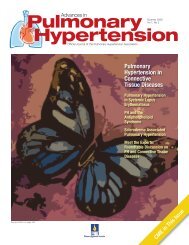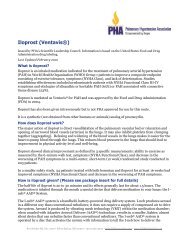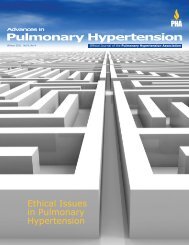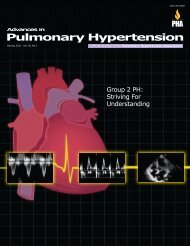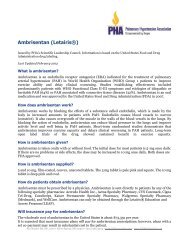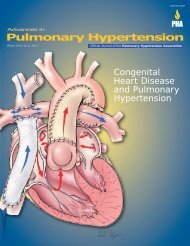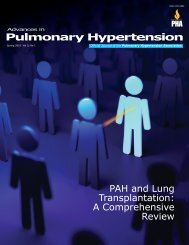Advances in Pulmonary Hypertension - PHA Online University
Advances in Pulmonary Hypertension - PHA Online University
Advances in Pulmonary Hypertension - PHA Online University
Create successful ePaper yourself
Turn your PDF publications into a flip-book with our unique Google optimized e-Paper software.
Editor’s Memo<br />
Bridg<strong>in</strong>g the Gap Between<br />
Specialists With Insights<br />
From an Expert Panel<br />
Often unsuspected and underappreciated,<br />
pulmonary arterial hypertension <strong>in</strong> some<br />
forms of scleroderma is much like primary<br />
pulmonary hypertension; the cause of the<br />
dyspnea and associated symptoms frequently<br />
eludes diagnosis until very late <strong>in</strong> the disease.<br />
Unfortunately, by that time, pulmonary<br />
hypertension may have reached an advanced<br />
stage less amenable to treatment. Although many patients with<br />
collagen vascular disease are considered at high risk for <strong>in</strong>flammatory<br />
pulmonary <strong>in</strong>volvement, the disease process is often<br />
<strong>in</strong>sidious and appropriate evaluation, <strong>in</strong>clud<strong>in</strong>g pulmonary<br />
function tests, echocardiography, and right-heart catheterization,<br />
may not be ordered when the benefit of treatment might<br />
be more substantial. One of the key issues concerns separat<strong>in</strong>g<br />
the potential causes of pulmonary hypertension that may occur<br />
<strong>in</strong> these patients and recogniz<strong>in</strong>g why they may require more<br />
aggressive follow-up to identify an evolv<strong>in</strong>g <strong>in</strong>flammatory component<br />
and potential progressive vasculopathy.<br />
Driven to F<strong>in</strong>d Cure<br />
for PH, Brundage<br />
Leads New Quest for<br />
Breakthrough <strong>in</strong> Therapy<br />
Bruce Brundage, MD, has seen it all,<br />
from the first anecdotal cases when<br />
no treatment for pulmonary hypertension<br />
was available, to the landmark<br />
National Institutes of Health<br />
(NIH) registry, to the large scale<br />
cl<strong>in</strong>ical trials of today <strong>in</strong>volv<strong>in</strong>g hundreds<br />
of patients. For anyone seek<strong>in</strong>g<br />
to chart progress <strong>in</strong> the field, his<br />
career serves as a bridge, spann<strong>in</strong>g<br />
milestones <strong>in</strong> the treatment of the disease. He has been<br />
associated with virtually every key development <strong>in</strong> the<br />
progress toward a cure, beg<strong>in</strong>n<strong>in</strong>g <strong>in</strong> the 1970s when he<br />
served as the director of the cardiac catheterization laboratory<br />
at the <strong>University</strong> of California, San Francisco.<br />
It was dur<strong>in</strong>g his study of those early cases, when he<br />
<strong>in</strong>serted catheters <strong>in</strong>to the pulmonary artery to measure<br />
the effects of various vasodilat<strong>in</strong>g drugs, that he began<br />
focus<strong>in</strong>g on pulmonary hypertension. Dur<strong>in</strong>g the last 25<br />
For these reasons, the <strong>Pulmonary</strong> <strong>Hypertension</strong> Roundtable<br />
discussion <strong>in</strong> this issue will have broad appeal to our<br />
readership, which <strong>in</strong>cludes cardiologists, pulmonologists, and<br />
rheumatologists. Clearly, this is a disease that is likely to present<br />
to each of these groups, and by transcend<strong>in</strong>g the boundaries<br />
of these specialties, our discussion offers <strong>in</strong>sights about<br />
its <strong>in</strong>cidence, evolution, and appropriate evaluation. From the<br />
diverse backgrounds of our experts, you will f<strong>in</strong>d cl<strong>in</strong>ical<br />
pearls relevant to your practice regardless of your specialty.<br />
One of the goals of <strong>Advances</strong> <strong>in</strong> <strong>Pulmonary</strong> <strong>Hypertension</strong> is to<br />
br<strong>in</strong>g you this k<strong>in</strong>d of distilled knowledge, based on contributions<br />
from the Scientific Leadership Council of the <strong>Pulmonary</strong><br />
<strong>Hypertension</strong> Association (<strong>PHA</strong>). These physicians are listed<br />
on page 2 and provide a tremendous breadth of experience<br />
gathered at lead<strong>in</strong>g <strong>in</strong>stitutions throughout the world. Their<br />
cont<strong>in</strong>ued <strong>in</strong>volvement with the journal gives us one of the<br />
clearest perspectives on the latest <strong>in</strong>formation <strong>in</strong> diagnosis<br />
and treatment.<br />
We appreciate the warm welcome <strong>Advances</strong> <strong>in</strong> <strong>Pulmonary</strong><br />
<strong>Hypertension</strong> has received <strong>in</strong> the medical community and<br />
look forward to fulfill<strong>in</strong>g the commitment <strong>PHA</strong> has made<br />
toward expand<strong>in</strong>g your awareness of manag<strong>in</strong>g this disease.<br />
We also welcome your comments and suggestions regard<strong>in</strong>g<br />
articles that appear <strong>in</strong> this issue by contact<strong>in</strong>g <strong>PHA</strong>.<br />
Vic Tapson, MD<br />
Editor-<strong>in</strong>-Chief<br />
years, research has been his passion—lead<strong>in</strong>g him to<br />
serve on the steer<strong>in</strong>g committee of the national registry<br />
and to play a key role <strong>in</strong> the growth of the 5,000-member<br />
<strong>Pulmonary</strong> <strong>Hypertension</strong> Association (<strong>PHA</strong>), of which he<br />
is now president. “It was <strong>in</strong> the late 1970s that I discovered<br />
the NIH was start<strong>in</strong>g its patient registry <strong>in</strong> pulmonary<br />
hypertension so I applied to have our center enrolled<br />
as part of the registry,” he said. “Soon afterward, I was<br />
<strong>in</strong>vited to be on the steer<strong>in</strong>g committee for the patient<br />
registry at a time when we began collect<strong>in</strong>g data <strong>in</strong> an<br />
organized manner.” Jo<strong>in</strong><strong>in</strong>g the faculty at the <strong>University</strong><br />
of Ill<strong>in</strong>ois at Chicago, Dr Brundage teamed with Stuart<br />
Rich, MD, and Paul Levy, PhD, two lead<strong>in</strong>g <strong>in</strong>vestigators,<br />
as they explored the effects of high-dose calcium channel<br />
blockers <strong>in</strong> treat<strong>in</strong>g pulmonary hypertension. “This was<br />
the first breakthrough <strong>in</strong> the treatment because we found<br />
there was a percentage of patients who were helped.”<br />
In 1990 Dr Brundage was named chief of the<br />
Department of Cardiology at Harbor-UCLA Medical Center<br />
and became <strong>in</strong>volved <strong>in</strong> the early studies of <strong>in</strong>travenous<br />
prostacycl<strong>in</strong> therapy. Enroll<strong>in</strong>g 300 patients to receive<br />
what was a new <strong>in</strong>fusion therapy at the time, he was a<br />
coauthor of a major paper published <strong>in</strong> the Journal of the<br />
American College of Cardiology demonstrat<strong>in</strong>g the longterm<br />
survival benefits of prostacycl<strong>in</strong>. At that po<strong>in</strong>t<br />
(cont<strong>in</strong>ued on page 20)<br />
<strong>Advances</strong> <strong>in</strong> <strong>Pulmonary</strong> <strong>Hypertension</strong> 3



